On August 7, 2017, two weeks before the Great American Eclipse of August 21, 2017, we will have a partial lunar eclipse. This will occur on August 8 in parts of Asia, Australasia, and the Pacific Ocean. The lunar eclipse will be visible from most parts of South and East Asia, Europe, Africa and Australia. Exact lunar phase will occur at 18:10 UTC / 14:10 EDT, and the greatest eclipse will occur at 18:20 UTC / 14:20 EDT. The less intense penumbral portion of the eclipse will extend from 15:50 to 20:51 UTC, and the stronger partial eclipse will extend from 17:23 to 19:18 UTC. According to NASA, the duration of the eclipse will be one hour and 55 minutes.
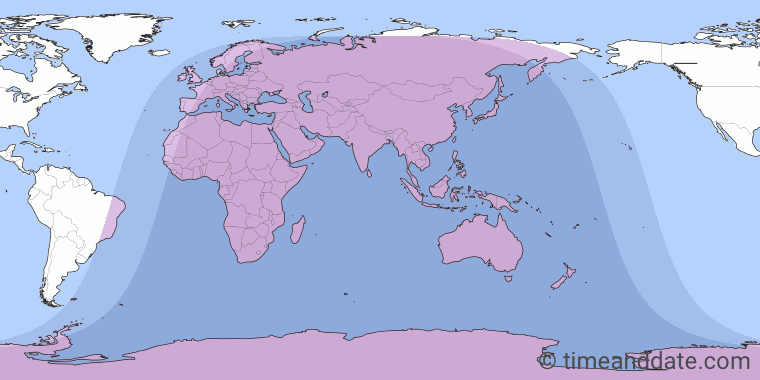
Above Image Credit: https://www.timeanddate.com/eclipse/lunar/2017-august-7
The term “eclipse” refers to the ecliptic, i.e., the Sun’s apparent path, where the Moon crosses the Sun’s path on the eclipse points. These points are the lunar nodes, where the Moon crosses in either a) an ascending path, called the North Node/Rahu/Dragon’s Tail or Caput Draconis, or b) a descending path, called the South Node/Ketu/Dragon’s Tail or Caudus Draconis. A lunar eclipse occurs on full Moon when the light of the Moon is blocked by the Earth’s shadow, at which time the Earth is between the Sun and Moon, or we say when the Sun and Moon are at opposition, or 180 degrees apart in opposite signs and houses. This solar and lunar eclipse YouTube animation helps to visualize the lunar nodes and eclipses, which are also shown below. You can see that they are not always in the same zodiacal longitude as the luminaries they eclipse.
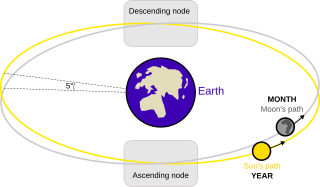
 Above: A lunar eclipse occurs in two regions, an outer penumbral shadow where the sunlight is dimmed, and an inner umbral shadow, where much dimmer sunlight only exists by refraction through the Earth’s atmosphere, leaving a red color. This can be seen in different exposures of a partial lunar eclipse, for example here with exposures of 1/80, 2/5, and 2 seconds, Tomruen – Own work, CC BY-SA 4.0, https://commons.wikimedia.org/w/index.php?curid=36147067
Above: A lunar eclipse occurs in two regions, an outer penumbral shadow where the sunlight is dimmed, and an inner umbral shadow, where much dimmer sunlight only exists by refraction through the Earth’s atmosphere, leaving a red color. This can be seen in different exposures of a partial lunar eclipse, for example here with exposures of 1/80, 2/5, and 2 seconds, Tomruen – Own work, CC BY-SA 4.0, https://commons.wikimedia.org/w/index.php?curid=36147067
Eclipses are sub-divided into “eclipse types” based on how completely the Sun or Moon is eclipsed, and these types are total, partial, and appulse/penumbral. In a partial lunar eclipse which is what we have on August 7, the Moon crosses the boundary of the Earth’s umbra (central cone of darkness which tapers away from the Earth or Moon), and also crosses the penumbra (outer cone of partial shadow which diverges instead of tapering), so it appears dark except for a normal looking crescent of brightness. In an appulse or penumbral eclipse, the Moon moves through only the Earth’s penumbra and is only slightly dimmed. On August 7, it is not only a partial eclipse but also includes a penumbral eclipse.
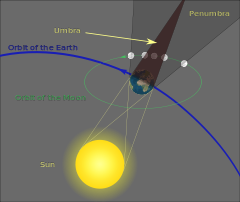 Above: schematic diagram of the shadow cast by the Earth. Within the central umbra shadow, the moon is totally shielded from direct illumination by the Sun. In contrast, within the penumbra shadow, only a portion of Sunlight is blocked.
Above: schematic diagram of the shadow cast by the Earth. Within the central umbra shadow, the moon is totally shielded from direct illumination by the Sun. In contrast, within the penumbra shadow, only a portion of Sunlight is blocked.
A lunar eclipse is not possible without a solar eclipse. They always occur two weeks apart during the full Moon and new Moon. The solar eclipse can occur either before or after the lunar eclipse, or both can occur: a lunar eclipse followed by a solar eclipse followed by a lunar eclipse, which is rare but will happen in the summer of 2018. The eclipses do have to happen exactly on the new and full Moon but because of the Moon’s tilt to the ecliptic and the Earth, an eclipse cannot happen every full or new Moon. A solar eclipse occurs within about 18.5 longitudinal degrees of the lunar nodes, and a lunar eclipse occurs within about 12.5 degrees longitude degrees of the lunar nodes. Celestial latitude is also taken into account for eclipse parameters. So the eclipse does not have to have the luminaries exactly conjoined the nodes, as we see in the August 7 eclipse when Ketu, the eclipsing shadow, is about 10 degrees ahead of the Moon (the nodes move backward).
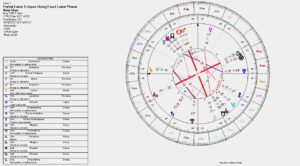
 Eclipses occur in the signs where the lunar nodes are transiting or close to transiting. For instance, the Moon’s South Node/Ketu will eclipse the Moon on August 7, when it will be at the zero degree (sandhi/edge) between Aquarius and Capricorn, and on August 17 (using mean nodal calculations), Ketu will enter sidereal Capricorn and Rahu will enter sidereal Cancer, and then in the August 21 eclipse, Rahu will be at 29 degrees of Cancer but the luminaries will be around 5 degrees of Leo, and then in 2018, the eclipses will be happening in this axis of Cancer-Capricorn for a while. The full Moon will be eclipsed at ~21 degrees of sidereal Capricorn. Ketu the “eclipser” will be at 0 degrees Aquarius using true node calculation, and about 0.5 degree Aquarius using mean node calculation. Either way, the node will be sandhi which makes it more indicative of some type of instability ahead which the lunar and solar eclipses will be triggering.
Eclipses occur in the signs where the lunar nodes are transiting or close to transiting. For instance, the Moon’s South Node/Ketu will eclipse the Moon on August 7, when it will be at the zero degree (sandhi/edge) between Aquarius and Capricorn, and on August 17 (using mean nodal calculations), Ketu will enter sidereal Capricorn and Rahu will enter sidereal Cancer, and then in the August 21 eclipse, Rahu will be at 29 degrees of Cancer but the luminaries will be around 5 degrees of Leo, and then in 2018, the eclipses will be happening in this axis of Cancer-Capricorn for a while. The full Moon will be eclipsed at ~21 degrees of sidereal Capricorn. Ketu the “eclipser” will be at 0 degrees Aquarius using true node calculation, and about 0.5 degree Aquarius using mean node calculation. Either way, the node will be sandhi which makes it more indicative of some type of instability ahead which the lunar and solar eclipses will be triggering.
In my experience, the degree of the Moon in a lunar eclipse, or Sun in solar eclipse, and the degree of the lunar nodes will all become important points to watch for forthcoming malefic transits. In this case and after the solar eclipse, many astrologers will be watching that sandhi point between Capricorn and Aquarius for the transit of Mars from 29 degrees Cancer into four degrees Leo which is in range in the last week of August and first week of September as it will trigger the lunar and solar eclipse “critical degrees” by conjunction and opposition. Some say it is critical for only two weeks after the lunar eclipse and six months or even years after the solar. We also hear that the duration of the effects of an eclipse will be a year for every hour the Sun is eclipsed, and a month for every hour the Moon is eclipsed.
An eclipse, whether visible or not, affects the entire world. According to Vedic astrology’s Sage Varāhamihira, if the solar eclipse occurs at the end of the pakña (fortnight) after the lunar eclipse, then the people in general tend to become unruly and unjust and couples quarrel and divorces/separation increases. In the reverse, i.e. the lunar eclipse occurs after the solar eclipse, the Brahmins and priests increase their prayers and people are more happy and contented. Since the summer of 2016, and through 2018, the eclipses are happening with the solar eclipse after the lunar eclipse (so we’re presumably more unruly for a while to go). In the summer of 2018 we will have a mixed bag solar-lunar-solar, but starting in 2019, the pattern will change back to solar followed by lunar (so presumably we’ll be more contented), for a while anyway.
According to Vedic astrologer Pandit Sanjay Rath, we can extend this same principle to those who have the eclipse occurring in the same nakshatra or rashi (sidereal sign) as the natal Sun. These individuals would be set on an easier path following a trend of higher spiritual growth, happiness, and contentment when the lunar eclipse comes after the solar eclipse. More overall stress, conflict, or unpredictable influences may occur for them when the lunar eclipse precedes the solar eclipse, which is the dynamic we have in place this summer.
Vedic astrologer Haizen Paige explained eclipses so beautifully in an article some time ago: “The cutting off of the light in an eclipse signals the withdrawal of light from the Earth and consequently some area of our consciousness and external life. When there is no light, a situation dies, and then there is a new beginning that takes place. Both the solar and lunar eclipses have a bearing on large chunks of our life: major issues of happiness in life, our sense of aliveness, where we live, what job we’re working in, relationships, and they will sometimes bring up important health issues that we would be unwise to ignore. These areas are highlighted according to the planets and houses where the eclipses land within a birth or mundane horoscope.”
A few days on either side of a lunar eclipse is considered somewhat unsteady, and thus is a time when it is best to “lie low.” Don’t initiate anything of a worldly matter during these days if you want it to be a lasting success. These periods are called the shadow of the eclipse. The lunar nodes Rahu and Ketu blocking the light of the Sun and Moon in both solar and lunar eclipses are a signal of endings and beginnings. If an eclipse aspects planets or sensitive points in a natal or mundane chart, the matters relating to that planet will be highlighted until the next series of eclipses six months ahead.
Often turning points are reached and new insights discovered in the areas of life an eclipse touches. An eclipse closely conjoining a planet or an angle cusp will cause that planet or point to vibrate at a higher frequency, bringing many changes. An astrologer will be able to prognosticate about what these changes might mean, and it depends on the natural significations of that planet or point, as well as aspects, yogas, other transits and progressions that are happening. The lunar eclipse can represent a culmination or reaping of something sown six months ago.
Additionally, as the lunar eclipse occurs with the opposition of the Sun and Moon, it can involve relationship themes, conflicts, or often the need to let go of something or someone. In a Ketu lunar eclipse such as this one, the vibrations in the months or weeks preceding — and possibly for a few weeks or months afterward — can feel exhausting or depressing, and we may have to deal with some emotional upsets. Ketu relates to our long-held, often unconscious patterns brought forward from the past, so at this time we may not be able to see clearly what is coming up around us or in our emotional experience…it can feel a bit murky as things get churned up so we have to wait a while to let things settle.
The August 7 lunar eclipse falls in the mysterious and magical constellation of Capricorn which is the sign that exemplifies the manifestation of Spirit in matter. Themes for a Capricorn eclipse may revolve around organization, work and profession, ambition, achievement, respect, and justice (or lack thereof). The eclipsed Moon will fall in Shravana nakshatra, which is one of the most easygoing and pleasant sections within sidereal Capricorn which relates to listening, contemplation, knowledge, organization, and music. The lunar eclipse here asks that we take some quiet time to tune in and really pay attention to the “small still voice within,” and also, to take time to simply en-joy life. Shravana nakshatra comprises the section of the zodiac which symbolizes the power of connection with source energy through the holy stream of life. The eclipse will occur in Cancer navamsa, the Moon’s own sign which relates to issues of inner and outer security.
The Moon opposes Mars in Cancer, an aspect that can reflect powerful emotions and some potential for arguments or violence. The last ten degrees (drekkana) of Capricorn are being stimulated or called to attention in this eclipse as the Moon and Ketu are flanking this section. Brihat Jataka assigns to this drekkana the image of a man wearing a maille or metal armor and carrying a bow and arrow. This could possibly imply a war or terror attack theme which is also indicated in the solar eclipse to follow, which I will write about in my next eclipse installment.
In the USA Kelleher chart, the eclipsed Moon falls near natal Ketu in the second house, which corresponds with the financial condition of the nation, the revenue, stock exchange, banks, commerce, and trade. On August 17, using mean node calculations, Ketu is moving back into Capricorn and the second house of this chart, and Rahu back into Cancer in the eighth house. This is called the nodal return when the transiting nodes return to their natal places, which will start to come into range in January 2018, but will be in exact aspect next spring of 2018. This return is a date with destiny for the USA and its collective consciousness, and incidents and events leading up to the nodal return may open the door to various kinds of cultural or economic turning points. Last time this occurred was ~19 years ago in the late summer and early fall of 1999, which was by all accounts a massive economic boom time. Perhaps the issues of some nodal return “rebirth and a new direction” in 1999 related to confronting and resolving the Y2K computer problem, and also major antitrust ruling against Microsoft Corporation which ultimately forced Microsoft to integrate its Windows operating system with competing software.

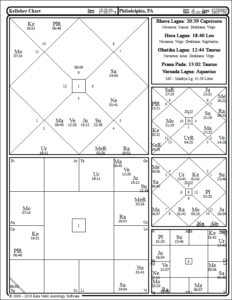 In this current lunar eclipse, Ketu falls in the third pada of Dhanistha nakshatra, Libra navamsa, which is in the most auspicious section of the this lunar sign which is associated with wealth. The Moon is receiving a very close trine from Jupiter, which usually is thought in mundane astrology to indicate increased revenue and prosperity for stocks and securities. With Ketu moving toward the second house of the Kelleher chart, it is possible that military affairs will require large amounts of money, but Jupiter’s almost exact trine to the lunar eclipse Moon might indicate some improvement in the national finances and possibly, some lessening of taxation. I also believe that Ketu is the karaka (indicator) of cryptocurrencies like Bitcoin and Ethereum, which will possibly in the coming 1.5 years+ continue to rise significantly in value.
In this current lunar eclipse, Ketu falls in the third pada of Dhanistha nakshatra, Libra navamsa, which is in the most auspicious section of the this lunar sign which is associated with wealth. The Moon is receiving a very close trine from Jupiter, which usually is thought in mundane astrology to indicate increased revenue and prosperity for stocks and securities. With Ketu moving toward the second house of the Kelleher chart, it is possible that military affairs will require large amounts of money, but Jupiter’s almost exact trine to the lunar eclipse Moon might indicate some improvement in the national finances and possibly, some lessening of taxation. I also believe that Ketu is the karaka (indicator) of cryptocurrencies like Bitcoin and Ethereum, which will possibly in the coming 1.5 years+ continue to rise significantly in value.

